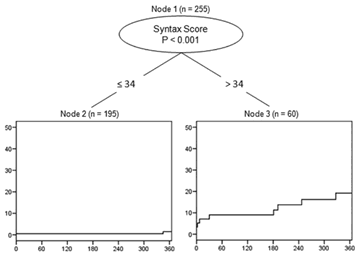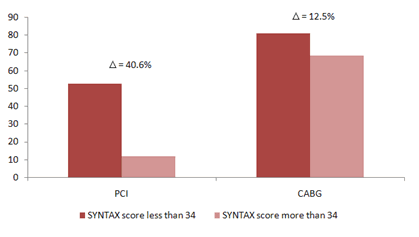Background
The EuroSCORE is a common and broadly accepted instrument to help predict early outcomes in patients who undergo coronary artery bypass grafting(CABG).
A similarly well validatedtool to stratify patients who are treated with percutaneous coronary intervention(PCI) is challenging to develop and hampered by several practical issues.
An ideal score for predicting clinical outcomes of PCI-treated patients should be :
- User-friendly.
- Validated and applicable to different clinical scenarios.
- Representative of the technical complexities and prognostic implications associated with a larger burden of coronary artery disease, (i.e a concern which is often typical of the percutaneous approach).
The goal to fully characterise the coronary vasculature in view of determining the extent of CAD has finally been reached with the release of the SYNTAX score (1).
This semi-quantitative score was specifically created by an expert consensus from the merger of several pre-existing classifications to prospectively characterise angiographies of individuals enrolled in the SYNTAX trial (2).
Variables which contribute to the determination of the score include : dominance, number of lesions, segment involved per lesions and presence of chronic total occlusions, trifurcation, bifurcation, aorto-ostial lesions, tortuosity, calcification, thrombi, long lesions and/or diffuse disease. According to different points attributed to these variables, a separate number is calculated for each lesion. These values are then summed up to generate the total SYNTAX score.
Due to this comprehensive variety of variables needed to obtain the score, one may find the SYNTAX score calculation to be cumbersome, time consuming and/or difficult to implement in clinical practice.
However as is the case with the EuroSCORE, online tools (e.g. http://www.syntaxscore.com/) are available to bypass practical issues and speed the process. Worth noting, is the acceptable core-lab reproducibility of SYNTAX score that has been reported (3).
1) Validation of the SYNTAX score
Its ability to anticipate cardiac mortality and composite outcomes was reported satisfactory in patients with multivessel CAD treated percutaneously (4). These findings, however, were not replicated in a similar validation study conducted in patients with multivessel CAD treated with CABG (5). A possible explanation for this inconsistency may be attributed to the specific ability of surgery to “bypass” coronary lesions irrespective of their angiographic complexity.
The SYNTAX score was also found to be a strong predictor of outcome both in patients treated with PCI (6) and patients treated with CABG (7) in the context of left main CAD.
In the PCI study (6),
- Patients were divided into tertiles based on SYNTAX scores: low (≤18), intermediate (>18 to 27) and high (>27).
- At 1 year, patients in the highest tertile showed a significantly higher mortality (13.1% vs 2.5%, P < 0.001) and MACE rate (21.4% vs 7.4%, P < 0.001) than patients in the lowest tertile.
- After adjustment, the SYNTAX score remained significantly associated with the risk of cardiac death (HR 1.15; 95% CI 1.05-1.26; P < 0.003) and MACE (HR 1.06; 95% CI 1.02-1.10; P = 0.005).
In a separate analysis, a SYNTAX score cutoff of 34 was found to be most effective in distinguishing patients at higher risk of mortality from cardiac causes after PCI (Figure 1).
2) Comparing the SYNTAX score with other scores
To date, few studies directly compared the performances of the SYNTAX score with ones obtained with other available scoring systems to grade the angiographic complexity of CAD.
A comparison of the SYNTAX score and the modified AHA/ACC lesion classification scheme in patients undergoing PCI found that the SYNTAX score shows a greater discrimination ability both in patients with multivessel disease and patients with left main disease (4,6).
Further comparison with existing clinical scores are warranted (e.g. with the New York State Model, Mayo Clinic score, Northern New England score) to deepen our understanding of the different impacts of assessing clinical and angiographic information in patients undergoing PCI.
3) Usefulness of the SYNTAX score
While the SYNTAX score has been shown to be significantly associated with clinical outcome after PCI, its application is currently a matter of debate. Here are some reasons to implement a clinical score into practice:
- Monitoring quality of care
- Providing objective information to health care providers, patients and their families
- Aiding patient’s selection for the most appropriate strategy of treatment.
In patients with left main CAD, this means selecting those patients who benefit most from CABG due to lower predicted rates of long term mortality.
While little doubt exists that patients with more advanced and extended CAD should be treated with CABG (as recommended by current guidelines), the use of the SYNTAX score is likely to prompt clinical decision making towards safely moving eligible patients at low risk of recurrent events towards a less invasive option of revascularisation.
This potential has been recently explored with the analysis of 819 patients undergoing revascularisation by PCI or CABG and enrolled in two Italian centers (8).
Among patients with a high SYNTAX score - defined as those with a SYNTAX score > 34 - , PCI was shown to be inferior to CABG in terms of 2-year mortality both before (Table 1) and after statistical adjustment to reduce the effect of selection bias and other potential confounders (adjusted hazard ratio: 2.54, 95% confidence interval: 1.09 to 5.92, p = 0.031).
Conversely, no differences were observed between PCI and CABG among patients presenting with a SYNTAX score ≤ 34 (adjusted hazard ratio: 0.81, 95% confidence interval 0.33-1.99, p = 0.64).
We suggested that a potential explanation for these findings may be attributed to different rates of complete revascularisation between patients treated with PCI and those treated with CABG (Figure 2). While in patients with less extensive CAD, PCI and CABG show comparable rates of complete revascularisation, CABG achieves highly superior rates in patients with a score above 34. This suggests that the SYNTAX score may be able to anticipate the ability of a percutaneous approach to obtain complete revascularisation in a given individual.
Figure 1: Binary splits based on classifications and regression tree analysis of 255 patients with unprotected left main treated with PCI. Of all tested univariate predictors of outcome, the SYNTAX score emerges as the best single discriminator between patients with and those without cardiac death (A) with a discrimination level of 34.

Figure 2. Differences of complete revascularisation rates per revascularisation treatment.

Future perspectives
Evidence that the SYNTAX score may identify a cohort of patients who benefit most from surgical revascularisation is encouraging, but large scale prospective studies are warranted to define the magnitude of this effect.
The SYNTAX score will be weighted with data of the 5-year follow up of patients enrolled in the SYNTAX trial. Meanwhile, further refinements of the score should be encouraged, such as a lighter version of the score itself or new models implementing clinical variables (e.g. diabetes mellitus, chronic kidney disease, rise of troponine levels) which are known to heavily affect mortality rates in patients with complex CAD.


 Our mission: To reduce the burden of cardiovascular disease.
Our mission: To reduce the burden of cardiovascular disease.